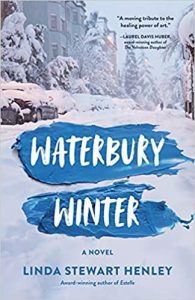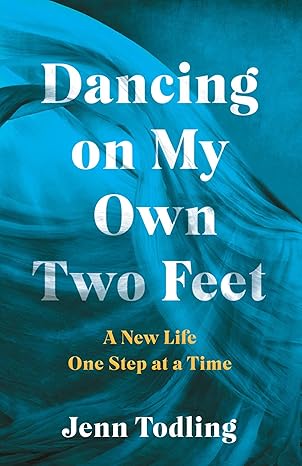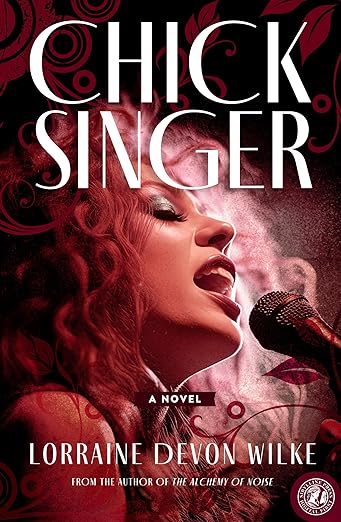Healing Grief and Addiction through art: a Conversation with Waterbury Winter author Linda Stewart Henley
Healing grief and addiction through art: a conversation with Waterbury Winter author Linda Stewart Henley
for Women Writers Women’s Books
 Historical novelist Ellen Notbohm asks some provocative questions in conversation with author Linda Stewart Henley about Henley’s new novel Waterbury Winter. Besides exploring protagonist Barnaby Brown’s mid-life journey through grief and addiction, Ellen and Linda exchange thoughts about writing, art, artists, and their work processes.
Historical novelist Ellen Notbohm asks some provocative questions in conversation with author Linda Stewart Henley about Henley’s new novel Waterbury Winter. Besides exploring protagonist Barnaby Brown’s mid-life journey through grief and addiction, Ellen and Linda exchange thoughts about writing, art, artists, and their work processes.
Ellen: Waterbury Winter’s protagonist, Barnaby Brown, follows a well-defined character arc, from hopeless to hopeful. After being widowed at 27, he abandons his promising career and falls into alcoholism, a dead-end job, and a friendless existence but for some regulars at the local bar. You’re a painter but not an alcoholic, a recluse, a slacker, or a widow. How did you conceive the character of Barnaby?
Linda: I’ve known people who had trouble with alcohol and I have a great deal of sympathy for the proverbial artist starving in an attic. Not necessarily starving in the literal sense, but artistically. True artists must create. If they don’t produce work that they consider acceptable, they feel incomplete. Barnaby doesn’t reflect my own life experiences, but if I lost my partner and a pet I’d had for 18 years, crashed my car, and worked for a long time in a job that wasn’t my calling, I might have ended up like him.
Ellen: So perhaps Barnaby is an Everyman—or Everyperson—in that any of us are only one tragedy away from slipping into a similar abyss? His wife bought him a parrot named Popsicle before she died because she thought it would ease his loneliness, avoid at least some of that slide. But when the story opens, Popsicle has been with Barnaby nine times longer than the time he had with his wife, and longer than most typical pets like cats and dogs live. So is Popsicle a pet, or is there a line where a pet crosses into a companion, or a life partner? At times Popsicle even seems like an adviser. In her own way, she gets the last word in the story. What role does Popsicle play in Barnaby’s descent into stagnation, and his journey back to life and hope?
Linda: Barnaby became a recluse after his wife’s death. He allowed himself to become immersed in grief and turned to the bottle for comfort. Shy and lacking in social skills, he came to depend on Popsicle for company, probably because she was easier to relate to, or easier to live with, since she didn’t make the kind of social demands that a human companion would. She also gave him something to care about—he took better care of her than of himself, and as parrots do, she needed a certain amount of emotional engagement as well. He took her for granted until he lost her. His first thought afterward was that because of his carelessness and drinking he was responsible for her death. When he found her, full of relief and joy, he took the first step toward recovery.
Ellen: As an alcoholic, how does Barnaby regain his self-respect? Do some of the story’s bad guys actually play a role in his determination to go sober and regain his career? A long-ago friend takes advantage of him by selling his paintings in a gallery and underpaying him. Later in the book Barnaby is outright ripped off by a secondary character posing as an art buyer. As readers, we don’t see it coming at all. But did Barnaby get some needed validation from knowing that others were willing to pay fairly big dollars for his work, even if the money didn’t come to him? How is he able to forgive, rather than sue for damages?
Linda: Barnaby’s story fits Abraham Maslow’s pyramid hierarchy of needs: basic security like food, clothing and a paycheck come first, and only after these needs are met can a person fulfill the higher needs of aesthetics and self-actualization. As the story begins, Barnaby has lived on the edge for a number of years. His irresponsible lifestyle has caught up with him: he’s in debt and about to lose his house because he has failed to make payments on an equity loan. So when his old friend offers to buy his paintings, his reaction is relief at having much needed cash rather than a feeling that his paintings have sold because they have value. Later on, he does come to feel validated artistically, and confident enough to demand fair compensation for his work. I wasn’t consciously thinking about this when I wrote the novel, but I see now that Maslow’s theory fits.
Ellen: O’Malley’s Bar is a central venue in the story, frequented by an interesting assortment of latent arts fans, not a typical feature of bars. In addition to Barnaby, a painter, there’s an incognito poet and a metal antique arts historian. And for balance, a social worker who turns out to be enough of a pool shark to take out the local (male) bigmouth champ. You seem to suggest that hidden skills and talents lurk in so-called ordinary people, and that they too seek self-actualization through their artistry, however subtly it comes across.
Linda: Sure, don’t they? We hear stories all the time about people who suddenly publish a book, paint a work of art, or display excellent skills as a musician. And then there are people like you, who create beautiful knitted garments. While not necessarily providing the artists with a living wage, these hidden talents may give them more lasting rewards overall.
Ellen: I think we can never be reminded enough that artistry and its rewards come in all manner of degrees. I do make a living wage at my writing, but nary a dime on my knitting and yet it has brought joy to many. So let’s talk about the writing process, the artistic process. Your son James created a marvelous painting of O’Malley’s that captures not only the aura of the place, but a specific moment in time. How do artists like Barnaby, James, and you confront a blank canvas? How is it like staring at the blank page before you write the first words of a book? How much of the construction happens in your head before you even pick up the brush or the pen?
Linda: I agree, James did create an amazing oil painting. I don’t work much with oil paints, so I won’t speak for James, but I always start a watercolor painting with a drawing. Scaling the image to fit the page is the first challenge. I outline the main composition in pencil, so it’s easy to erase if something doesn’t work. I only start to paint once the basic drawing is in place. Starting with the blank paper in a drawing is very different than that first blank page of a book, because when I choose a subject to paint I have a scene or flower in front of me. I’m not creating something from scratch, just trying to render something in a new way.
Writing for me is much harder, though. In some ways, writing historical fiction is easier than pure fiction because, just as in painting where I have a pencil drawing to follow, the historical events can serve as a kind of outline for the story. In historical fiction, you work the imaginative details around the facts. With pure fiction, your imagination has to do all the work to conceptualize the story and characters and make it all flow.
Ellen: As writers, we often tussle with ourselves (and our editors!) over where and how to end our book. It’s so very important to hit that last note just right. Without giving away the ending, how did you decide to end the story where you did? It is hopeful but by no means settled. Where is the line between tying up all loose ends and leaving something significant to the reader’s imagination?
Linda: The ending must satisfy the reader. When authors publish a book, they make a promise to the reader that it will be worth reading. They start with a premise, and the book can’t end until enough of the questions or problems posed at the beginning are answered. The loose ends important to the plot should be tied up, but it’s perhaps better to leave a little ambiguity for the reader’s imagination to explore. I ended Waterbury Winter when it reached that point. It was never intended to be a saga.
Ellen: But because you hit that sweet spot, it could be. Just sayin’.
Linda: You never know . . .
***

Ellen Notbohm
Ellen Notbohm is the author of The River by Starlight, winner of the Sarton Women’s Book Award, the Western Writers of America Spur Award, the Independent Publishers Book Awards Gold Medal, and numerous other literary awards. She is the editor of record for Linda Stewart Henley’s novels Estelle and Waterbury Winter.
Explore her work at https://ellennotbohm.com and on social media.
Linda Stewart Henley is the award-winning author of Estelle (2020). Waterbury Winter, published in May 2022, is so far a finalist for the Chanticleer International Mark Twain Book Awards as well as for the International Book Awards for general fiction.
Website: www.lindastewarthenleyauthor.com
Facebook: www.facebook.com/lindastewarthenley
WATERBURY WINTER, Linda Stewart Henley
BUY HERE
Category: Interviews, On Writing

 Barnaby Brown has had enough of freezing winters, insurmountable debt, a dead-end job, and his solitary life as a young widower with no one but his beloved parrot Popsicle. He yearns to move to California and reawaken his long-lost early life as an artist. But new troubles come in threes. His ancient car crashes into a snowbank. Popsicle escapes through a window carelessly left open.
Barnaby Brown has had enough of freezing winters, insurmountable debt, a dead-end job, and his solitary life as a young widower with no one but his beloved parrot Popsicle. He yearns to move to California and reawaken his long-lost early life as an artist. But new troubles come in threes. His ancient car crashes into a snowbank. Popsicle escapes through a window carelessly left open.


























